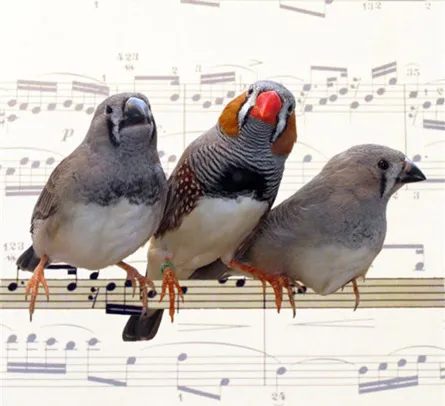Songbird chicks’ version of baby talk doesn’t come from an immature version of the grown-up brain’s song pathway. Instead, the bird babbling arises from its own brain circuit.

MIT’s Michale Fee and his colleagues studied the pathways for bird song by disabling various parts of zebra finch brains with drugs or with surgery. The experiments show that early bird sounds are driven by a brain pathway called LMAN (for lateral magnocellular nucleus of the nidopallium), the researchers report in the May 2 Science.
Much like a human infant’s jabbering, a male zebra finch’s first raspy tweets show lots of variety, suggesting that the chick is learning the basics of how its vocal system works. As the chick grows, it narrows its vocalizations, closing in on the recognizable elements of the classic zebra finch song. During this transition, Fee says, the main adult song pathway called HVC (high vocal center) becomes involved and comes to dominate song production.
The babbling pathway is a surprise, says David F. Clayton of the University of Illinois at Urbana-Champaign. Clayton also studies the neurobiology of bird song and says that chicks begin to tweet nonsense to themselves around 30 days after hatching, roughly the time the HVC pathway is forming. Researchers had generally assumed that HVC was responsible for the singing and that LMAN was just modifying, perhaps cleaning up, the early warblings instead of actually driving the process. He now predicts “a bit of rethinking about the mechanisms that underlie vocal development.”
Song learning in birds, Clayton says, “is the only good animal model of vocal learning, and it is probably the best model for any form of developmental sensorimotor learning.”
As Fee puts it, what the zebra finches are doing isn’t so far from the process of a person learning to play a musical instrument or to serve a tennis ball. Like other songbirds, very young male zebra finch chicks absorb the music of adults and then gradually work their way toward producing those sounds themselves. He compares the process to “any case where we have an idea of what we want to do but have to practice hard to do it.”
Fee says he got interested in bird babbling when he disabled the long-known HVC brain pathway for song in adult zebra finches. “Rather than being unable to sing at all, they revert to babbling,” he says. They sound very much like zebra finches only a month to six weeks out of their eggs. At that age, chicks learning to sing make “a quiet, scratchy, rambling mumbling,” Fee says.
In his latest work, Fee and his colleagues measured activity in LMAN. Neurons in this pathway fire 15 milliseconds before the chicks make a noise. That supports the idea that LMAN is driving the babble.
Knocking out LMAN in a half-grown bird that’s made progress in learning its song reduced the variability of the singing. Instead of warbling all over the place, the youngster repeated the same sounds consistently. “It’s not the right song, but it’s stereotyped,” Fee says.
The variability of zebra finch song also features in the work of Sarah C. Woolley of the University of California, San Francisco. She studies the anterior forebrain pathway, which includes LMAN. It plays some role in adult song too, and she says she’d like to know more about it.






